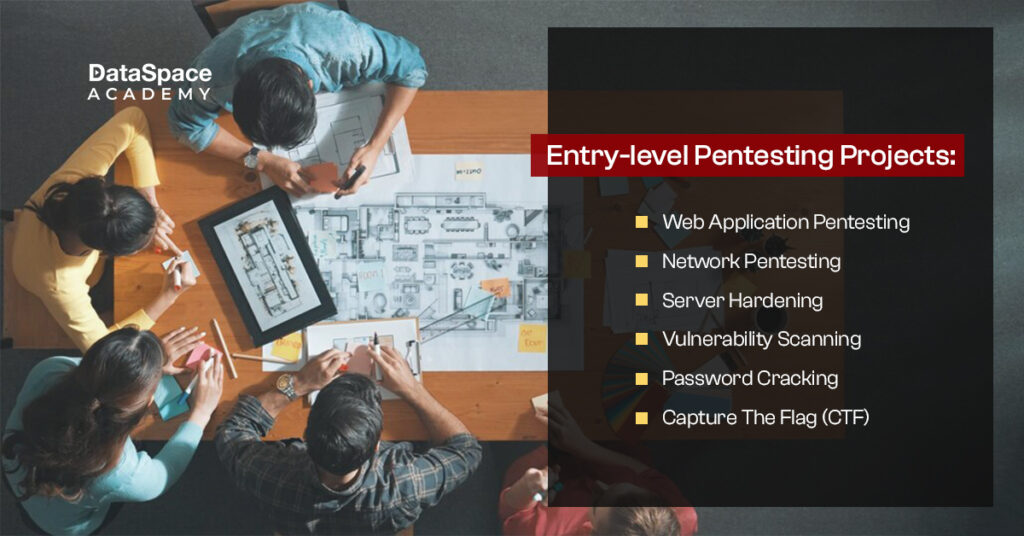Penetration Testing Projects for Beginners: Top 6 For a Promising Career
Last Updated : 09 Sep, 2024
 58.24K
58.24K

Introduction
Strengthening and maintaining a robust security posture is a crucial organisational aspect against unauthorised intrusion and breaches. Among various cyber security practices, penetration testing is an effective prevention technique. Pentesters or ethical hackers periodically perform tests to uncover security gaps in an organisation’s network or devices and suggest remedial measures to prevent cyber attacks. The growing rise in security breaches has skyrocketed the demand for certified ethical hackers or pentesters. If you too are aspiring to build a promising career in pentesting, there are both online and offline courses to opt for. Alongside, you must also hone your pentesting skills by completing penetration testing projects for beginners.
This blog is your absolute ethical hacking and penetration testing guide on the best beginner projects for pentesters.
Importance of Completing Pen Testing Projects
Penetration testing beginners projects are crucial for an impressive portfolio.
These projects are your gateway to gain hands-on experience and a clear understanding of theoretical knowledge and real-world application. For beginners, these projects allow to showcase practical skills, build confidence, and enhance resume credibility – enabling them to stand out before employers. Additionally, pentesting projects help develop problem-solving abilities, a deeper understanding of security tools, and familiarity with current attack vectors. These factors are essential for staying relevant and competitive in the field of cybersecurity today.
Top Penetration Testing Projects for Beginners

Some of the beginner-level pentesting projects are described below:
- Duration – 10-12 hours
- Complexity level – Medium
- Basic knowledge required – Web development and web security principles
- Project outcomes – Candidates gain a clear understanding of the website vulnerabilities
- Real-world applications – Uncovering and addressing web application defects to boost security
- Duration – 10-15 hours (adjustable)
- Complexity level – Easy
- Basic knowledge required – Networking fundamentals (TCP/IP, OSI), operating systems, security tools like Nmap, and command-line interface proficiency
- Project outcomes – Ability to perform network scanning, identifying and exploiting network vulnerabilities, and expertise in various pen testing tools
- Real-world applications – Enhancing cybersecurity defenses for businesses and improving network security policies and incident response strategies
- Duration – 6-8 hours.
- Complexity level – Medium
- Basic knowledge required – Linux/Windows server environments, networking, and security concepts
- Project outcomes – Identify and mitigate common server vulnerabilities, understand best practices for secure server configurations, and conduct basic security audits on server setups
- Real-world applications – improving servers’ security posture for deployment in production environments
- Duration – 6 hours.
- Complexity level – Easy
- Basic knowledge required – Web security concepts, and networking protocols
- Project outcomes – Proficiency in vulnerable assessment techniques.
- Real-world applications – Detecting web security flaws and improving web application security
- Duration – 3 hours.
- Complexity level – Easy
- Basic knowledge required – Command-line tools, password structures, and OS (Linux/Windows OS)
- Project outcomes – Proficiency with password vulnerabilities
- Real-world applications – Strengthening passwords and improving password policies
- Duration – 10-15 hours
- Complexity level – Easy
- Basic knowledge required – Network, programming, and common vulnerabilities.
- Project outcomes – Complete understanding of the security concepts and tools, exploiting vulnerabilities, and skills in secure coding practices.
- Real-world applications – Developing secure applications and enhancing personal or organisational security posture.
1. Web Application Pentesting:
The project involves the use of various tools like OWASP ZAP, DVWA, and WebGoat. Here is the breakdown of this project structure:
2. Network Pentesting:
Beginners can gain hands-on experience in network pen-testing on various platforms like Metasploitable, and websites like Hack The Box, TryHackMe etc.
3. Server Hardening:
This project introduces essential security practices to safeguard servers like Ubuntu Server and Windows Server by identifying vulnerabilities and implementing basic hardening techniques.
4. Vulnerability Scanning:
Learners gain insights on vulnerability scanning using tools like Nessus, and OpenVAS.
5. Password Cracking:
Candidates gain practical experience in various password-cracking tools like John the Ripper and Aircrack-ng.
6. Capture The Flag (CTF):
Beginners can practice the project on platforms like CTF365, and Hack The Box.

Conclusion
Pentesting projects for beginners offer practical experience to the aspirant in identifying and addressing security vulnerabilities. In other words, projects are crucial for developing foundational skills. If you are looking forward to building a career in pentesting, join our industry-leading penetration testing training and certification course. Added to theoretical classes, our course extends the opportunity to work on practical projects as well.
 58.24K
58.24K




































































































